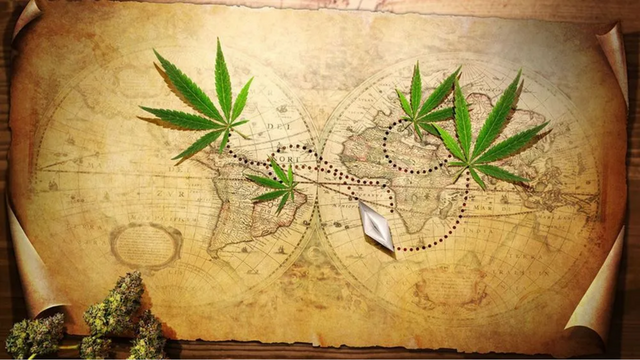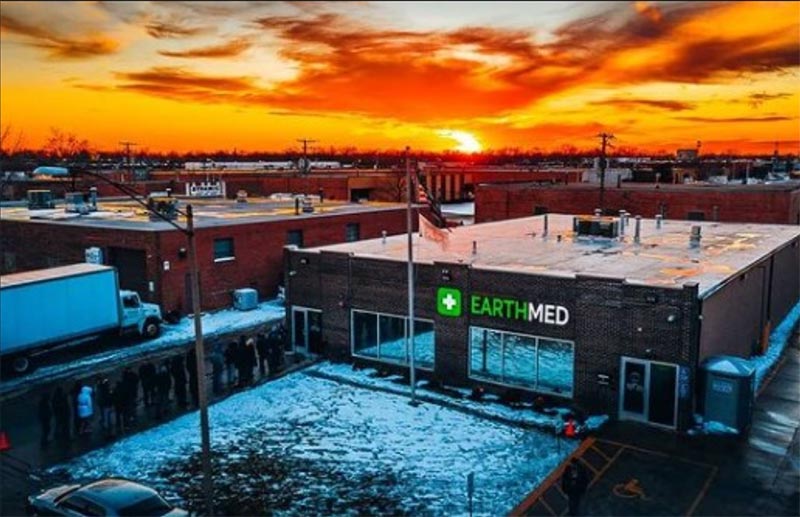Are you at least 21 years of age or hold a valid medical marijuana card?
Daily Specials
{{ special.title }}
{{ special.description }}
*{{ note }}EARTHMED BLOG

A Brief History of Cannabis Consumption

The rapid growth of cannabis culture in the last 60 years (ever more so in the last 20) is exciting when considering the complete history of marijuana. Many young tokers may think that our history started in the last 100 years, but evidence suggests that parts of the marijuana plant have been used since ancient times. Let’s dive into the history of marijuana use across time and cultures around the world.
Evolution of the Marijuana Plant
Research on some of the earliest fossil records indicates that close ancestors of the marijuana plant existed up to 34 million years ago. The hops plant, a close relative of the marijuana plant, was fully developed about 6.38 million years ago, giving us an idea of how long cannabis has been on this planet.
Initially found in central China, some historians believe that cannabis plants are some of the earliest crops to be farmed. Before we fully understood the medicinal properties of hemp, farmers grew marijuana to use as a material to make rope, paper, and even clothing. Perhaps 5,000 years ago, people were literally wearing weed on their backs!
Evidence of First Application
Based on findings from archeological dig sites around the world, people have used cannabis plants for thousands of years. Eventually, ancient Chinese medicine recognized that the cannabis plant offered a wide array of health benefits. At the time, people did not use this herbal medicine to " get high " as we do now. Instead, they used it to alleviate pain, reduce inflammation, and restore appetite.
While our ancient cannabis-consuming ancestors were not using multi-layered grinders, kief catchers, and rolling papers, they were still using the plant to enjoy a milder psychoactive effect. Remember that the marijuana plants from thousands of years ago were not as potent as they are today. Studies have shown that cannabis strains from thousands of years ago were not as high in THC. With THC’s effect on the human body playing a considerable role in how high someone feels, reduced effects are to be expected. Eating or smoking cannabis plants from this time would hardly provide a buzz.
Thousands of years ago, cannabis plants were often burned in a pseudo-brazier, used as an aromatic, or eaten. Historians discovered one of the first recorded forms of edibles in India. Consumed in many parts of India up to 3,000 years ago, “Bhang” is made using a crushed cannabis paste mixed into foods and beverages. In fact, to this day, Bhang is still used in religious ceremonies and celebrations throughout India and central Asia.
Globalization of Marijuana
Throughout history, various cannabis plants have been grown worldwide, and some of these landrace strains are still around today. But it wasn’t until around 1000 AD that cannabis became a more relevant pillar of trade in the east. Cannabis was imported from central Asia into parts of Korea, the Middle East, and North Africa before eventually being introduced to the West. By the 1600s, marijuana crops were found throughout Europe and South America, eventually finding their way into North American plantations.
First Restrictions & Legalization
As it began spreading worldwide, marijuana plants were quickly becoming outlawed. In the late 1300s, one of the first recorded bans on cannabis consumption came from a prince in Arabia. As many parts of the world started to prohibit the growing and consumption of the plant, marijuana remained legal in the United States until the 1900s.
At the turn of the century, the U.S. faced propaganda campaigns describing the drug as a danger to consumers and society. In the 1920s, prohibitions began popping up state by state until the Uniform State Narcotic Drug Act labeled cannabis as a drug across the country. To this day, the Controlled Substances Act of 1970 outlaws all use of marijuana at the federal level.
Despite the prohibition, individual states have legalized cannabis for medical and recreational use, but the substance is still illegal at the federal level. Across the world, there are plenty of other countries that have legalized cannabis, and the list is still growing.
Over the past few millennia, countless people and cultures around the world have used the cannabis plant as a medicinal herb, ceremonial mixture, or clothing. Despite restrictions and regulations in recent history, we cannot overstate the benefits marijuana has provided to humanity. We’re likely living in the golden age of weed, with our best days yet to come!
What’s your favorite part about the history of cannabis? Hit me up on social media, and let’s spark up a conversation about it!
{{ locations[0].name }}
{{ locations[0].address }}{{ locations[0].city }}, {{ locations[0].state }} {{ locations[0].zip }}
{{ locations[0].phone }}
Hours
Sun: {{ locations[0].hours_recreational.Sunday }}Mon: {{ locations[0].hours_recreational.Monday }}
Tue: {{ locations[0].hours_recreational.Tuesday }}
Wed: {{ locations[0].hours_recreational.Wednesday }}
Thu: {{ locations[0].hours_recreational.Thursday }}
Fri: {{ locations[0].hours_recreational.Friday }}
Sat: {{ locations[0].hours_recreational.Saturday }}
{{ locations[1].name }}
{{ locations[1].address }}{{ locations[1].city }}, {{ locations[1].state }} {{ locations[1].zip }}
{{ locations[1].phone }}
Hours
Sun: {{ locations[1].hours_recreational.Sunday }}Mon: {{ locations[1].hours_recreational.Monday }}
Tue: {{ locations[1].hours_recreational.Tuesday }}
Wed: {{ locations[1].hours_recreational.Wednesday }}
Thu: {{ locations[1].hours_recreational.Thursday }}
Fri: {{ locations[1].hours_recreational.Friday }}
Sat: {{ locations[1].hours_recreational.Saturday }}






